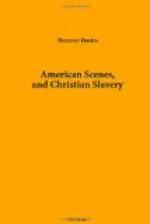Ohio.—In this and the Western States every township is divided into so many sections of a mile square; and one of these sections, out of a given number, is devoted to the maintenance of schools. As a township increases in population, the reserved section advances in value. These schools are not subject to any central control, but are under the management of a committee chosen by the township.
Still education is not so general in all the States as might be wished. Miss Beecher, the daughter of Dr. Beecher, having devoted to the subject much time and talent, tells us that there are in the United States “a million adults who cannot read and write, and more than two millions of children utterly illiterate and entirely without schools!” Of the children in this condition, 130,000 are in Ohio, and 100,000 in Kentucky.
In the working of this system of education, the absence of a State Church affords advantages not enjoyed in England. Of late, however, an objection to the use of the Bible in these schools has been raised by the Roman Catholics, and the question in some States has been fiercely agitated. In the city of St. Louis the Bible has been excluded. In Cincinnati the Catholics, failing to exclude it, have established schools of their own.
This agitation is one of great interest. It leads thoughtful and devout men to ask, whether, when the State, assuming to be the instructor of its subjects, establishes schools, and puts Protestant Bibles, or any other, or none into them by law, they have not thenceforth Protestantism, Popery, or Infidelity so far by law established; and whether it is not better that the State should restrict itself to its proper function as the minister of justice, leaving secular instruction, like religious, to the spontaneous resources of the people.
To this, I think, it will come at last. The Common School economy is a remnant of the old Church-and-State system, which has not been entirely swept away. But for this impression I should feel some uneasiness, lest it should prove the germ of a new order of things leading back to State-Churchism. It appeared to me quite natural to say, “Here is a State provision for schools,—why not have a similar provision for churches? It works well for the one,—why not for the other? Is it not as important that our churches should rely, not alone on the capricious and scanty efforts of the voluntary principle, but also on the more respectable and permanent support of the State, as it is that our Common Schools should adopt this course?” To me it seemed that the arguments which recommended the one supported the other; but when I have mentioned to intelligent men the possibility, not to say probability, of the one step leading to the other, they have invariably been surprised at my apprehensions, and have assured me that nothing was more unlikely to take place.




